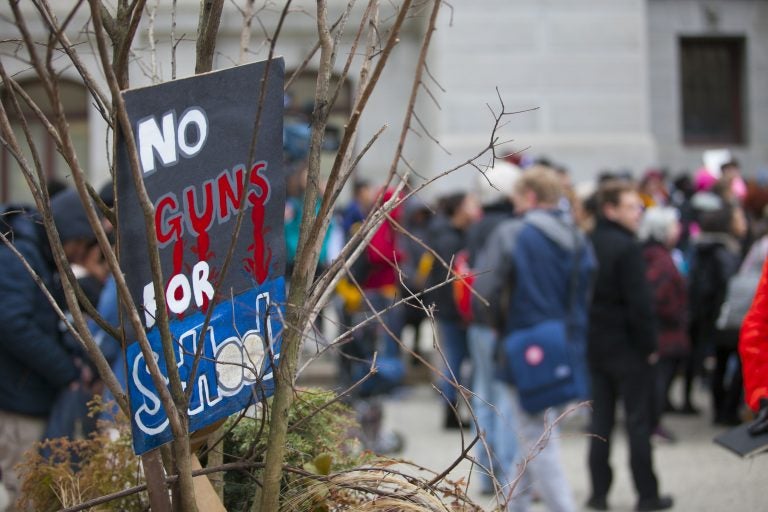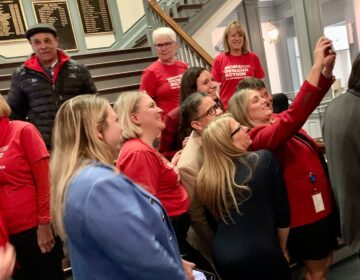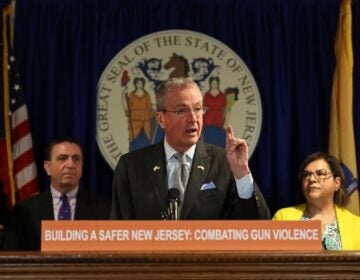Thinking of my teachers and the absurdity of arming them
America’s teachers don’t need guns. What they need is a commitment to preserve schools as places where students and staff feel safe and nourished.

Philadelphia students walk out of their schools to raise awareness about issues of school safety and the impact of gun violence. (Miguel Martinez)
My fourth-grade teacher, Marlene Johnson, instructed us to lie on the floor, close our eyes, imagine clouds wafting overhead, then sit up and write poems about them. She made us memorize the iambic trot of Rudyard Kipling’s “If” — all four verses, starting, “If you can keep your head when all about you/are losing theirs and blaming it on you …”
When Mrs. Johnson found me hunched over a giant book on the human body, staring at drawings that showed the development of a fetus from limbless bean to tucked-up baby, she commented quietly, “It’s pretty interesting, don’t you think?”
And after she told me and my squirrelly classmates about the baby incubating in her own womb, the fourth-grade parents pooled funds and bought her a high chair as an end-of-year present.
A week after the Parkland shooting, in which 17 were killed, President Donald Trump floated the notion of arming some teachers and school staff, an idea the White House underscored on Sunday.
“If you had a teacher who was adept with the firearm, they could end the attack very quickly,” Trump said in the White House State Dining Room last month, face-to-face with students and parents who shared wrenching accounts of school shootings and demanded action on gun violence.
“They’d go for special training, and they would be there, and you would no longer have a gun-free zone,” he continued. “Gun-free zone to a maniac — because they’re all cowards — a gun-free zone is ‘let’s go in and let’s attack because bullets aren’t coming back at us.’ ”
I’ve been trying to imagine Mrs. Johnson packing a pistol or couching one in the drawer of her blond wooden desk, next to the Band-Aids and the extra staples. Instead of Lamaze classes, she’d head for the rifle range after school. Perhaps that end-of-year gift would be a holster that cleverly doubles as a diaper bag.
What’s absurd is that, to Trump and his deep-pocketed, gun-toting allies, this scenario is not absurd. In fact, the NRA has been pushing the idea ever since the December 2012 shooting at Sandy Hook Elementary School. Even before all the victims (20 children, aged 6 and 7, and six adults) were buried, the NRA was boosting a National School Shield Program that would furnish every school in America with armed guards.
That dream didn’t come to pass (alas, Smith & Wesson, which nevertheless reported bumper profits in the year following Sandy Hook), but several states enacted bills permitting licensed teachers to keep their weapons locked and loaded at school.
I’ve been trying to torque my mind around that image, rescripting my own school days, in which the most potent weapon a teacher could wield was a phone call home or a brusque send-off to the principal’s office.
Which faculty members would step up for that “special training”? Perhaps my eighth-grade science teacher, a round-shouldered man who used to pace the classroom during exams, scraping a metal file across a glass petri dish to make a bone-chilling squawk of repetitive noise. He called it a “pressure test” and said it would prepare us for college.
With an AR-15 in his lab cabinet, maybe he’d have fired a couple of warning shots into the acoustic-tile ceiling, just to keep us on our toes.
Or maybe the eager markswoman would be my health teacher, the one who shocked parents on back-to-school night by sketching the female reproductive system in chalk on the front of her kilt. Yes, she seemed like a pacifist, but she must have harbored the occasional fantasy of revenge — for instance, after the time another faculty member stashed a dildo in her locker, or when notes scrawled “dyke” appeared in her office mailbox.
What about the physics instructor, the one we suspected was getting high in the back room before class, or the English teacher who was a frustrated novelist, or the one, half-deaf and near retirement, whom we used to torment by whispering, “May I go to the bathroom?” only to hear her thunder back, “No, you may not have a pencil!”
Would I want a gun in any of their hands? In the possession of any teacher, whose job — especially if they work in an underfunded public school — is already nearly untenable with the needs of students, the pressures of high-stakes testing, and the demands of bureaucracy?
Classrooms are volatile places, particularly today, when so many children carry a load of trauma in their backpacks, and part of a teacher’s job is to model healthy, effective ways of discharging conflict — strategies that don’t include discharging firearms.
I once taught, as a visiting writer, to an elementary class whose teacher became increasingly exasperated with a boy who refused to sit down and listen. She shouted at him, threatened to call his mother, and finally grabbed a metal pencil sharpener from a shelf and flung it across the room.
No one was hurt. But that incident showed me that teachers can crack, just like any human being on a very bad day in a setting that tests our patience and equanimity.
It also reminded me — because that teacher was white, and the child African-American — that race-based assumptions percolate through every school. Students of color already experience disciplinary action — suspensions and expulsions — at higher rates than their white peers; certainly they would be at greater risk if faculty packed lethal weapons.
America’s teachers don’t need guns. What they need is a commitment, backed by public dollars and legislative gusto, to preserve schools as places where students and staff feel safe and nourished, where they can think, question and take creative risks. Where they can experience mastery and leadership. Where they can dare to fail.
I want to see teachers armed with empathy, imagination and a touch of irreverence. I want them to pack high-caliber texts and innovative approaches to learning. I want them to teach as if their lives, as if all our lives, depended on that moment in the classroom: that filament of understanding, that spark of joy.
The Palestinian-Lebanese scholar Salma Jayyusi wrote, “If we read one another, perhaps we won’t kill one another.”
Let’s etch that over every school entrance, from coast to coast, right next to the brave and faithful plaque declaring it a gun-free zone.
WHYY is your source for fact-based, in-depth journalism and information. As a nonprofit organization, we rely on financial support from readers like you. Please give today.




